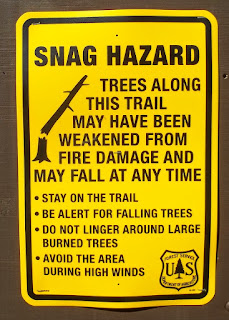The BAER Team has an objective they use to determine their scope of work - To identify imminent post-wildfire threats to human life and safety, property, and critical natural or cultural resources on National Forest System lands and take immediate actions, as appropriate, to manage unacceptable risks.
The critical values the BAER Team uses are: Human life and safety, property, Natural Resources and Cultural and Heritage Resources.
How BAER Works
The BAER team determines which fires they will respond to using various priorities and values above. The first criteria is the fire is over 500 acres. Smaller fires may qualify if there is a large risk to life, property and/or resources.
For Western North Carolina the following fires the BAER team will be developing plans for are:
- Dick's Creek Fire
- Boteler Fire
- Camp Branch Fire
- Maple Springs Fire
- Tellico Fire
- Knob Fire
- Rock Mountain Fire (Georgia BAER Team)
For these fires the BAER team will submit a request to do treatments, as well as where treatment is not needed or recommended.
Those recommendations are based on the Critical Values of the BAER team and the BAER Risk Assessment Matrix, using the magnitude of the consequences of not treating against the probability of damage or loss.
The Critical Values that the BAER Team assess are:
Human Life and Safety - on National Forest System (NFS) lands only
Property - Buildings, water systems utility systems, road and trail prisms, dams, wells and other significant investments on NFS's land
Natural Resources - Water used for municipal, domestic, hydropower, or agricultural - Soil productivity - Critical habitat or suitable occupied habitat for federally listed threatened or endangered species - Native or naturalized communities on NFS lands - all on NFS lands
Cultural and Heritage Resources - Cultural resources which are listed on or potentially eligible for the National Register of Historic Places, Traditional Cultural Properties, or Indian Sacred Sites on NFS lands.
Once determining that a site is within the Critical Values, the BAER team then determines the risk associated with that site. To help determine the amount of risk, the BAER team uses a Risk Assessment Matrix to give it a value.
The BAER Risk Assessment Matrix looks at damage and determines the magnitude of consequences on a scale of major, moderate or minor. That is then taken into consideration against the Probability of Damage or Loss. The two combined formulate the risk associated with each item identified.
Probability of
Damage or Loss: The following
descriptions provide a framework to estimate the relative probability that
damage or loss would occur within 1 to 3 years (depending on the resource):
Magnitude of
Consequences:
|
When potential hazards to life or safety on NFS lands are identified, notification of hazardous or unsafe conditions should accompany any other contemplated actions. For potential flooding or other threats that may continue downstream of NFS lands, coordinate and cooperate with the appropriate response agencies.
Once these threats are identified and rated, Emergency Response Actions are recommended for the identified areas. When scheduling emergency response actions, those that protect life and safety should have highest priority.
Part of the strategy of these actions can be for the natural recovery of area. Administrative closures can be used to protect life and safety to prevent additional risk. Or other effective measures should be applied to manage unacceptable risks.
Response Action Considerations are done with the consultation with other agencies to ensure emergency response actions are appropriate, wilderness response occurs where appropriate, and in prevention of invasive species.
For full details of what the BAER team does, and how it determines responses, you can get a downloadable and printable version of their manual here.



No comments:
Post a Comment